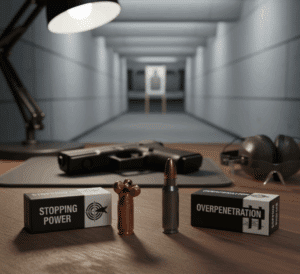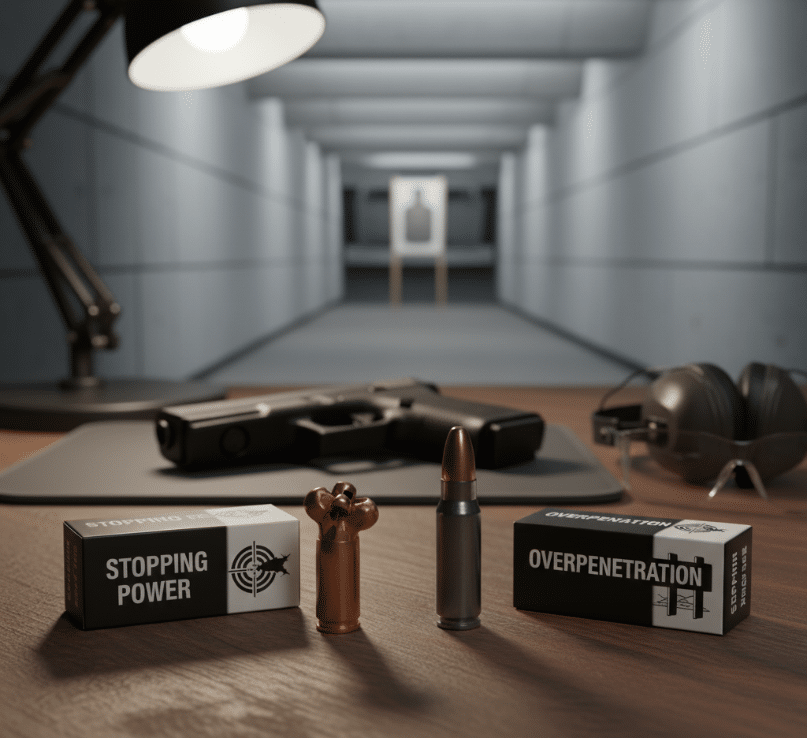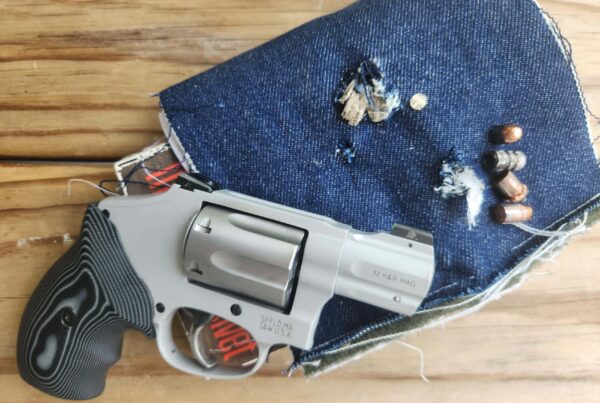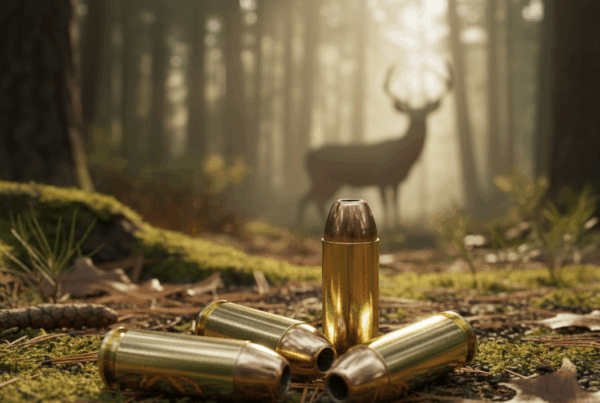When choosing the right ammunition for self- defense, two terms dominate the conversation: stopping power and over penetration. Both are critical, but they often pull gun owners in opposite directions. Some prioritize maximum effectiveness in stopping a threat, while others worry about the safety risks if a bullet travels beyond its intended target.
So, which should carry more weight stopping power or over penetration? The answer lies in understanding what each means, how different ammo types perform, and how to make the best choice for your specific situation.

What Is Stopping Power?
Stopping power refers to a bullet’s ability to incapacitate a threat quickly. In self-defense scenarios, every second counts. You want ammunition that ends the danger as fast as possible to protect yourself or your loved ones. Stopping power is synonymous with terminal effectiveness or even performance. Oftentimes the term stopping power evokes Hollywood imagery of bad guys being carried across a room after being struck with a bullet. While it may not launch a body through the air, or even instantaneously stop the threat, we will use stopping power interchangeably with terminal effectiveness.
Key factors influencing stopping power include:
- Bullet Energy – Higher velocity and mass increase the energy delivered.
- Expansion – Hollow point and other more advanced bullet technologies are designed to expand on impact, creating a larger permanent would channel.
- Shot Placement – Even the most powerful ammo you can carry is only effective if it hits vital areas.
Example: A well-placed shot with a hollow point round from a 9mm handgun will often neutralize a threat more efficiently than a non-expanding round with greater penetration.
What Is Overpenetration?
Overpenetration happens when a bullet passes completely through its target .While this may sound effective, in self-defense it creates a major risk: the bullet can hit an unintended person, object, or wall behind the target.
Why overpenetration is dangerous:
- Home Defense Scenarios – Bullets can pass through drywall, doors, or furniture.
- Crowded Environments – In public, a round could strike innocent bystanders.
- Legal & Ethical Responsibility – You’re accountable for every bullet you fire.
The Balance Between Stopping Power and Overpenetration
The challenge for gun owners is finding ammunition that delivers enough stopping power without posing excessive overpenetration risks.
- Excessive energy for your application – Higher chance of bullets traveling through the target.
- Too little stopping power – The attacker may remain a threat, even after being shot.
This is why ammo selection is such a hot topic among concealed carriers, law enforcement, and homeowners.
Ammo Types for Self-Defense
Not all ammunition is created equal. Let’s break down the most common self-defense rounds and how they perform in terms of stopping power and penetration:
1. Full Metal Jacket (FMJ)
- Stopping Power: Low
- Overpenetration Risk: Very High
- Verdict: Best for training, not for defense. FMJ bullets rarely expand and are likely to pass through a target.
2. Hollow Point (HP)
- Stopping Power: High
- Overpenetration Risk: Low to Moderate
- Verdict: Most recommended for self-defense. Designed to expand and transfer maximum energy inside the target
3. Frangible Ammo
- Stopping Power: Moderate
- Overpenetration Risk: Very Low
- Verdict: Breaks apart on impact, reducing risk of collateral damage. Useful in environments where safety is critical (apartments, crowded areas).
4. +P or +P+ Rounds
- Stopping Power: Very High
- Overpenetration: Moderate to High, depending on bullet construction
- Verdict: Higher pressure and velocity increase effectiveness but potentially penetration risk. Understand the loads before carrying or loading in defensive guns.
Factors to Consider When Choosing Self-Defense Ammo
When selecting the best ammo for self-defense, consider these real-world factors:
1. Environment
- Home defense in an apartment? Minimize overpenetration risk.
- Rural or open-area defense? Stopping power may take priority over the risk of overpenetration
2. Firearm Type
- Handguns are most common for self-defense, but caliber and barrel length affect performance.
- A 9mm hollow point behaves differently than a more powerful 357 Magnum
3. Legal Considerations
- Some jurisdictions restrict ammo types. Always confirm what’s legal in your area.
4. Training & Familiarity
- Accuracy matters more than caliber debates. Choose ammo you can shoot consistently and confidently.
Stopping Power vs. Overpenetration: Expert Insights
Most experts agree that hollow point ammunition strikes the best balance. It offers strong stopping power while reducing the risk of overpenetration. Law enforcement agencies across the U.S. largely rely on hollow point rounds for this reason.
However, there’s no one-size-fits-all solution. For example:
- A homeowner in a suburban neighborhood may choose frangible ammo or a cartridge with less energy to address overpenetration concerns.
- A concealed carrier might prefer a superior bullet technology like a bonded JHP or a Solid Copper Hollow Point (SCHP).
Conclusion: Which Matters More?
So, which matters more, stopping power or the risk of overpenetration? The truth is both are equally important. You need enough stopping power to neutralize a threat quickly, but not so much penetration that your rounds endanger others.
For most gun owners, hollow point bullets remain the best self-defense choice. They provide reliable expansion, effective stopping power, and reduced overpenetration risk.
Ultimately, the best ammo is the one that fits your firearm, your environment and your responsibility as a gun owner. Train regularly, test different rounds, and choose ammunition that balances performance with safety.
FAQ’s
Q1: How much damage does stopping power do?
A. It determines how quickly a bullet can incapacitate a target, creating enough trauma to stop a threat.
Q2: Which caliber has more stopping power?
A. Larger calibers and expanding bullets (like hollow points) generally deliver more stopping power.
Q3: Does a .45 really have more stopping power than a 9mm?
A. Not always; modern 9mm hollow points can match or exceed .45 ACP performance with less recoil.
Q4: What has more stopping power, .44 Magnum or .45 ACP?
A. The .44 Magnum has more stopping power due to higher velocity and energy, but alsoore recoil and overpenetration risk.
Related Posts
What Makes The .38 Special A Great Self-Defense Round?
Old Reliable for Self-Defense Today.







